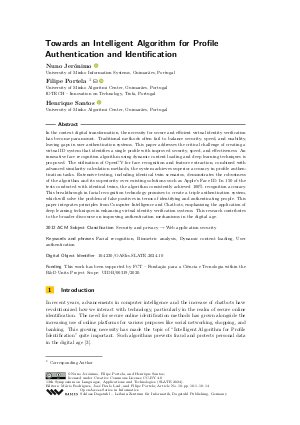Towards an Intelligent Algorithm for Profile Authentication and Identification
Authors
Nuno Jerónimo  ,
Filipe Portela
,
Filipe Portela  ,
Henrique Santos
,
Henrique Santos 
-
Part of:
Volume:
13th Symposium on Languages, Applications and Technologies (SLATE 2024)
Part of: Series: Open Access Series in Informatics (OASIcs)
Part of: Conference: Symposium on Languages, Applications and Technologies (SLATE) - License:
 Creative Commons Attribution 4.0 International license
Creative Commons Attribution 4.0 International license
- Publication Date: 2024-11-14
File

PDF
OASIcs.SLATE.2024.10.pdf
- Filesize: 0.58 MB
- 14 pages
Document Identifiers
Subject Classification
ACM Subject Classification
- Security and privacy → Web application security
Keywords
- Facial recognition
- Biometric analysis
- Dynamic content loading
- User authentication
Metrics
- Access Statistics
-
Total Accesses (updated on a weekly basis)
0PDF Downloads0Metadata Views
Abstract
In the context digital transformation, the necessity for secure and efficient virtual identity verification has become paramount. Traditional methods often fail to balance security, speed, and usability, leaving gaps in user authentication systems. This paper addresses the critical challenge of creating a virtual ID system that identifies a single profile with improved security, speed, and effectiveness. An innovative face recognition algorithm using dynamic content loading and deep learning techniques is proposed. The utilisation of OpenCV for face recognition and feature extraction, combined with advanced similarity calculation methods, the system achieves superior accuracy in profile authentication tasks. Extensive testing, including identical twin scenarios, demonstrates the robustness of the algorithm and its superiority over existing solutions such as Apple’s Face ID. In 150 of the tests conducted with identical twins, the algorithm consistently achieved 100% recognition accuracy. This breakthrough in facial recognition technology promises to create a triple authentication system, which will solve the problem of false positives in terms of identifying and authenticating people. This paper integrates principles from Computer Intelligence and Chatbots, emphasizing the application of deep learning techniques in enhancing virtual identity verification systems. This research contributes to the broader discourse on improving authentication mechanisms in the digital age.
Cite As Get BibTex
Nuno Jerónimo, Filipe Portela, and Henrique Santos. Towards an Intelligent Algorithm for Profile Authentication and Identification. In 13th Symposium on Languages, Applications and Technologies (SLATE 2024). Open Access Series in Informatics (OASIcs), Volume 120, pp. 10:1-10:14, Schloss Dagstuhl – Leibniz-Zentrum für Informatik (2024)
https://doi.org/10.4230/OASIcs.SLATE.2024.10
BibTex
@InProceedings{jeronimo_et_al:OASIcs.SLATE.2024.10,
author = {Jer\'{o}nimo, Nuno and Portela, Filipe and Santos, Henrique},
title = {{Towards an Intelligent Algorithm for Profile Authentication and Identification}},
booktitle = {13th Symposium on Languages, Applications and Technologies (SLATE 2024)},
pages = {10:1--10:14},
series = {Open Access Series in Informatics (OASIcs)},
ISBN = {978-3-95977-321-8},
ISSN = {2190-6807},
year = {2024},
volume = {120},
editor = {Rodrigues, M\'{a}rio and Leal, Jos\'{e} Paulo and Portela, Filipe},
publisher = {Schloss Dagstuhl -- Leibniz-Zentrum f{\"u}r Informatik},
address = {Dagstuhl, Germany},
URL = {https://drops.dagstuhl.de/entities/document/10.4230/OASIcs.SLATE.2024.10},
URN = {urn:nbn:de:0030-drops-220817},
doi = {10.4230/OASIcs.SLATE.2024.10},
annote = {Keywords: Facial recognition, Biometric analysis, Dynamic content loading, User authentication}
}
Author Details
- University of Minho Algoritmi Center, Guimarães, Portugal
- IOTECH- Innovation on Technology, Trofa, Portugal
Funding
This work has been supported by FCT – Fundação para a Ciência e Tecnologia within the R&D Units Project Scope: UIDB/00319/2020.
References
- Youssif Abuzied, Mohamed Ghanem, Fadi Dawoud, Habiba Gamal, Eslam Soliman, Hossam Sharara, and Tamer Elbatt. A privacy-preserving federated learning framework for blockchain networks. Cluster Computing, pages 1-18, March 2024. URL: https://doi.org/10.1007/s10586-024-04273-1.
- Matthew Barrett. Framework for improving critical infrastructure cybersecurity version 1.1, 2018-04-16 2018. URL: https://doi.org/10.6028/NIST.CSWP.04162018.
- Kaikai Deng, Ling Xing, Longshui Zheng, Honghai Wu, Ping Xie, and Feifei Gao. A user identification algorithm based on user behavior analysis in social networks. IEEE Access, 7:47114-47123, January 2019. URL: https://doi.org/10.1109/ACCESS.2019.2909089.
- Sanjay Dhurandher, Jagdeep Singh, Petros Nicopolitidis, Raghav Kumar, and Geetanshu Gupta. A blockchain-based secure routing protocol for opportunistic networks. Journal of Ambient Intelligence and Humanized Computing, 13:1-13, April 2022. URL: https://doi.org/10.1007/s12652-021-02981-9.
- Shirley Gregor and Alan Hevner. Positioning and presenting design science research for maximum impact. MIS Quarterly, 37:337-356, June 2013. URL: https://doi.org/10.25300/MISQ/2013/37.2.01.
- Muskan Khan. Advancements in artificial intelligence: Deep learning and meta-analysis, July 2023. URL: https://doi.org/10.31219/osf.io/twyfh.
- Hongyu Liu and Bo Lang. Machine learning and deep learning methods for intrusion detection systems: A survey. Applied Sciences, 9(20), 2019. URL: https://doi.org/10.3390/app9204396.
- Bill Manaris. Natural language processing: A human-computer interaction perspective. Advances in Computers, 47:1-66, December 1998. URL: https://doi.org/10.1016/S0065-2458(08)60665-8.
- Mark Ogonji, George Okeyo, and Joseph Wafula. A survey on privacy and security of internet of things. Computer Science Review, 38:100312, November 2020. URL: https://doi.org/10.1016/j.cosrev.2020.100312.
-
Ken Peffers, Tuure Tuunanen, Marcus Rothenberger, and S. Chatterjee. A design science research methodology for information systems research. Journal of Management Information Systems, 24:45-77, January 2007.

- Soorya Ramdas and Neenu Agnes. Leveraging machine learning for fraudulent social media profile detection. Cybernetics and Information Technologies, 24:118-136, March 2024. URL: https://doi.org/10.2478/cait-2024-0007.
- Yi Sun, Xiaogang Wang, and Xiaoou Tang. Deep learning face representation by joint identification-verification, 2014. URL: https://arxiv.org/abs/1406.4773.
- Zitong Yu, Yunxiao Qin, Xiaobai Li, Chenxu Zhao, Zhen Lei, and Guoying Zhao. Deep learning for face anti-spoofing: A survey. IEEE Transactions on Pattern Analysis and Machine Intelligence, 45(5):5609-5631, 2023. URL: https://doi.org/10.1109/TPAMI.2022.3215850.
